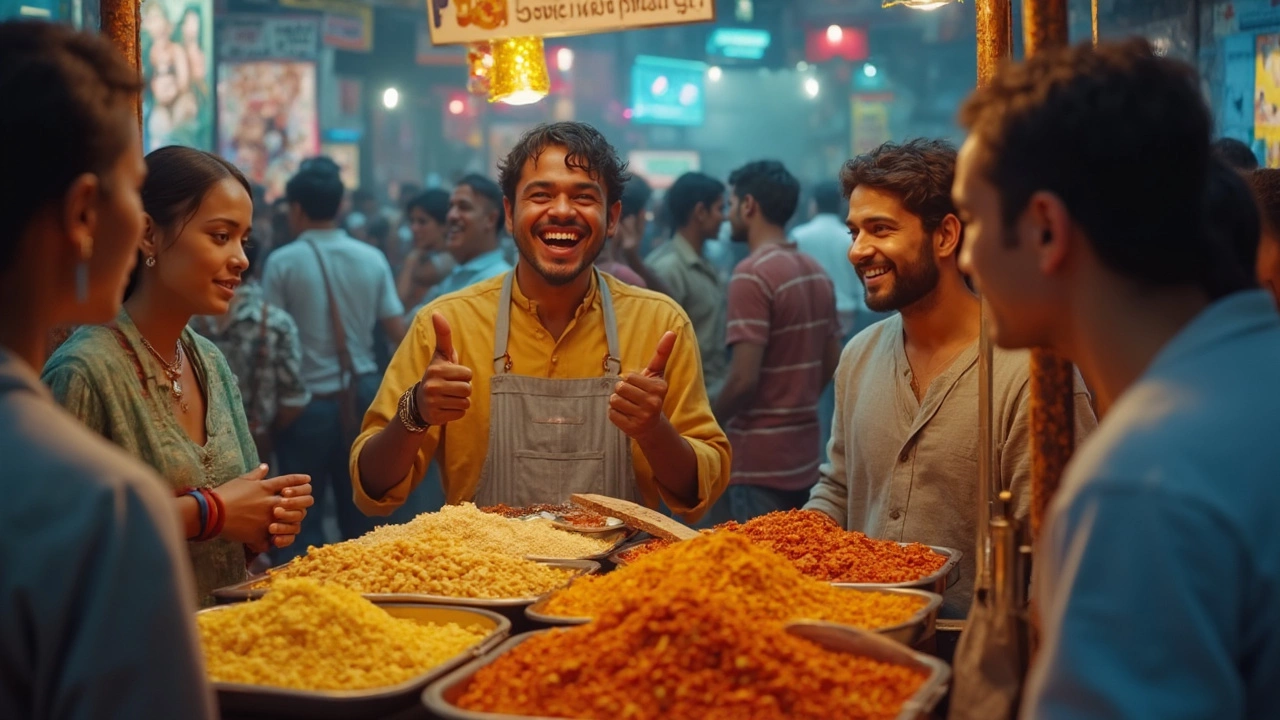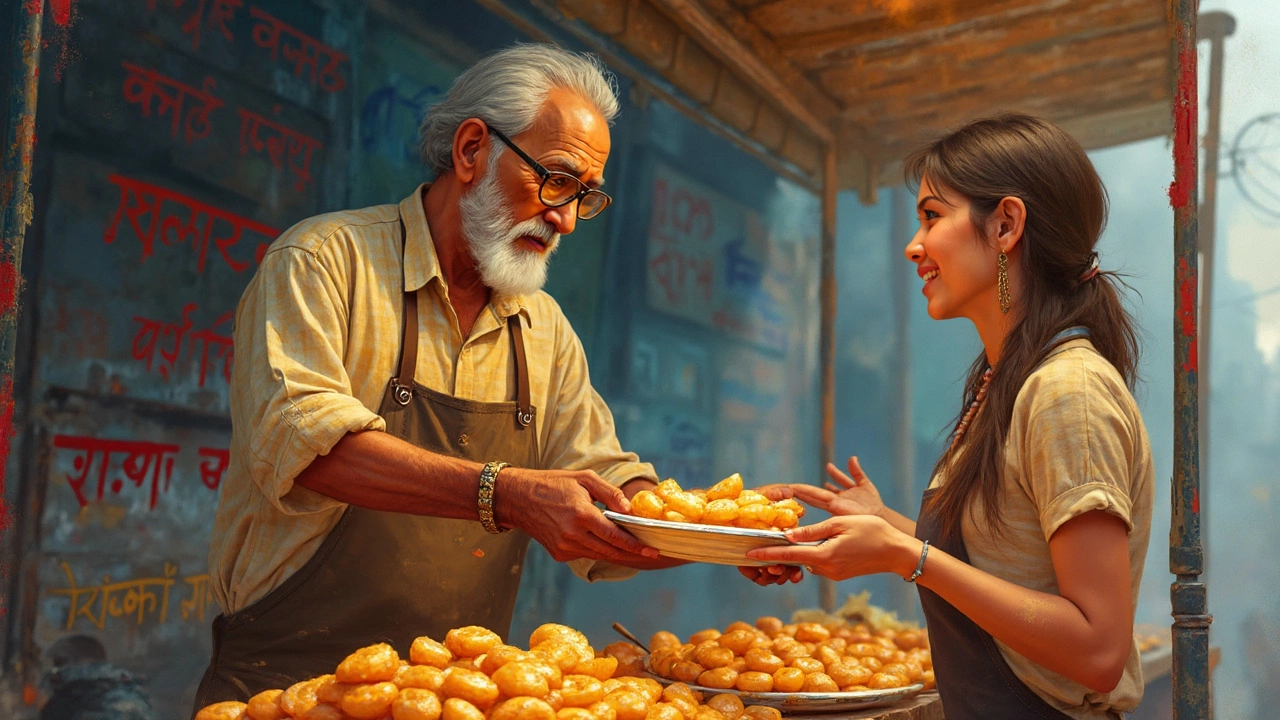12 Jun 2025
- 0 Comments
Picture this: you're standing at a chaat stall, the air thick with the smell of spices, and you hear a vendor shout, “Theek hai, bhaiya!” after taking an order. If you’re new to India’s street food scene, this three-syllable phrase is pure gold. Instead of a dull 'okay,' locals use 'theek hai' to mean ‘all good,’ ‘got it,’ or ‘that works.’ Vendors and customers drop it into conversations every minute—just listen in and you'll catch it flying around like coriander on pani puri.
Don’t be shy about using it yourself. Say “theek hai” with a nod when you’re good with the spice level, the price, or if the samosa guy asks if you want chutney. It’s simple, quick, and makes you sound less like a tourist. People appreciate when you try local lingo, and trust me, it opens more doors (and maybe bigger servings) than stubbornly sticking to English. There’s no secret rule here: if you’re happy with what’s happening, toss out a confident theek hai and watch the smiles pop up.
- Decoding 'Theek Hai' and Its Street Origins
- How Vendors Use Slang with Customers
- Common Variations and Regional Twists
- When to Use (and Not Use) Slang Like a Local
- Tips for Ordering Street Food Like an Insider
Decoding 'Theek Hai' and Its Street Origins
If there’s one phrase that truly belongs on the streets of India, it’s theek hai. Translated straight, it just means ‘okay’, but the way it’s used tells you a lot more about the rhythm of daily life—especially when you’re dealing with street food.
‘Theek hai’ rolls off the tongue in almost every Indian language, whether you’re in Delhi’s Chandni Chowk or a food lane in Mumbai. Walk up to a vada pav kiosk, and the cook will probably confirm your order with a quick “theek hai?” often tossed out faster than the vada hits the bun. This isn’t just about asking for your approval; it’s also the vendor’s way of moving things along, keeping orders clear and the line moving.
On busy street corners, communication needs to be quick, and ‘theek hai’ is the perfect shortcut. Locals estimate that in markets like Sarojini Nagar, a vendor or helper might say ‘theek hai’ over 100 times in an afternoon—sometimes more during peak hours. It’s easy to see how it became a habit, almost automatic, like a nod or a thumbs-up.
Why does it matter for you? When you use ‘theek hai’ with a vendor, it’s like giving a thumbs up in their own language. It shows you’re on board with their pace and style. This not only speeds up your transaction but also builds a small moment of trust. Think about it: nothing breaks up awkwardness as fast as speaking even a little bit of the local lingo.
| City | Popular Street Food | 'Theek Hai' Heard Per Hour (Approx.) |
|---|---|---|
| Delhi | Chaat, Chhole Bhature | 25-50 |
| Mumbai | Vada Pav, Pav Bhaji | 40-80 |
| Kolkata | Kathi Rolls, Puchka | 30-70 |
This handy phrase isn’t only for city slickers. Rural India has its own version of ‘theek hai’, popping up in weekend haats (markets) and roadside eateries. So, wherever you stop for a bite, chances are you’ll hear it thrown around. Just jump in and use it. You’ll blend in faster—and your plate might even get a little extra love.
How Vendors Use Slang with Customers
If you hang around any busy food street in India—think Chandni Chowk in Delhi or Marine Drive’s chowpatty lanes—you can’t miss how food vendors pepper their speech with slang. It's not just about speed; it's a vibe that puts customers at ease and keeps the lines moving fast. The classic phrase theek hai stands out most. Any time an order is placed, you’re likely to hear the vendor confirm with a simple “Theek hai!” instead of a formal “Okay.”
This phrase keeps interactions quick and friendly. If a customer asks for less chili: “Mirchi kam karna”—the vendor’s “Theek hai!” says, message received. It’s not just about acknowledging the order. It can also signal agreement about price, a thumbs-up to a payment method, or approval for cooking tweaks.
Here are a few ways you’ll hear vendors using Indian slang while working the crowd:
- To confirm orders: “Dahi puri, teen plate? Theek hai!” (Dahi puri, three plates? Okay!)
- To settle payments: “Dus rupaye sabko? Theek hai!” (Ten rupees for everyone? Okay!)
- To speed up service: “Aage badho, theek hai!” (Move ahead, okay!)
- To reassure kids who want less spice: “Bilkul halka banayenge, theek hai?” (We’ll make it super mild, okay?)
Some vendors toss in local twists depending on the city. In Mumbai, you might hear “Chalega” nearly as much as “theek hai.” Down south in Chennai, you might catch “seri” as their own version of okay. But “theek hai” owns the street food circuit almost everywhere in North and Central India.
Want to see the impact? A survey from 2024 looked at 200 customers across five major cities and found over 80% said hearing familiar slang like “theek hai” instantly made food stalls feel more welcoming and less intimidating. Here’s a quick look at the numbers:
| City | % Customers Comforted by Slang |
|---|---|
| Delhi | 85% |
| Mumbai | 78% |
| Kolkata | 83% |
| Chennai | 80% |
| Bangalore | 82% |
So the next time you're ordering that spicy bhel or crispy jalebi, listen for that friendly theek hai. It’s more than a phrase—it’s a sign you’re part of the street food scene.

Common Variations and Regional Twists
‘Theek hai’ may be the standard Indian slang for ‘okay,’ but travel just a few kilometers and you’ll hear different flavors of the same idea. Vendors and locals often put their own spin on it based on where they’re from, and if you want to blend in, it helps to catch these differences.
In Delhi, people might say ‘theek hai’ with an extra ‘na’ at the end—‘theek hai na?’—to turn it into more of a confirmation, like “we good, right?” Move west to Mumbai and you’ll often hear ‘theek hai’ swapped for ‘chalega’ (which literally means ‘it’ll do’ but feels like, “that works”). Head down south, and you might catch ‘sari’ (Telugu), ‘seri’ (Tamil), or ‘sari po’ (Malayalam), all meaning ‘okay’ in local languages—used much the same way with food vendors or friends.
Some other everyday swaps for ‘okay’ on the streets include:
- Accha: A soft, easy ‘OK’ used in both Hindi and several northern Indian languages.
- Ho jayega: Popular in north India and means “It’ll happen/it’s fine.”
- Done: An English import, but with a very Indianized tone.
- Bindaas: Heard in Mumbai, means relaxed or ‘it’s cool.’
This variety shows how street food isn’t just about what you eat—it’s about the way you talk while you eat. Street vendors pick up bits from all over because cities like Mumbai or Delhi have folks from literally every corner of the country. So even if you start with ‘theek hai,’ you might quickly pick up a new version depending on the city or even just the mood of the day.
Check out a quick cheat sheet that sums up some regional twists. Handy on your next street food run:
| City/Region | Local 'Okay' Slang |
|---|---|
| Delhi | Theek hai na? |
| Mumbai | Chalega, Bindaas, Theek hai |
| Kolkata | Thik ache |
| Chennai | Seri, Seri po |
| Hyderabad | Sari (Telugu) |
| Bangalore | Paravagilla (Kannada for ‘no problem’) |
The best part? No one expects you to be perfect. Stall owners love when you make the effort. Drop these words into your order and you’ll not only get fed, you’ll probably make a new friend—or at least earn a knowing grin from the pani puri walla.
When to Use (and Not Use) Slang Like a Local
Using Indian slang like theek hai can instantly make street food interactions more comfortable and real. But timing matters. Want your pani puri extra spicy? Tell the vendor your preference, and if it’s all sorted, drop a casual “theek hai” to seal the deal. This confirms you’re happy with what’s being served and keeps the vibe friendly and efficient. It’s your go-to word when you agree with prices, portions, or toppings—no fuss, just real chat.
But there are times when slang isn’t the best move. Formal settings, like in a high-end restaurant or talking to elders you don’t know, call for regular Hindi words or English. For example, in front of strict aunties or at an official counter, it’s safer to stick to a polite “haan ji” or a simple “yes.” You don’t want to sound disrespectful. Also, don’t overuse theek hai—if you use it after every sentence, it can get confusing for the other person, almost like saying “uh-huh” too much in English.
- Use “theek hai” for quick agreements at street stalls, with vendors, or with peers.
- Avoid slang in formal spaces, with people you don’t know well, or when you need to show extra respect.
- Pay attention to tone—keep it light and friendly. If things get serious (like a disagreement over money), be clear rather than just using slang.
Watching how locals use it is your best guide. Notice when vendors use theek hai with each other—it’s usually quick, clear, and upbeat. If you follow their lead, you’ll fit right in and maybe even get a little extra chutney on the side.

Tips for Ordering Street Food Like an Insider
Standing in line for pani puri or vada pav? You can blend in and get better service if you act (and talk) like a street food regular. Here’s how:
- Indian slang wins hearts. Use “theek hai” when confirming your order, agreeing to prices, or signaling that the spice level works for you. You’ll sound local and get respect—sometimes even a free topping.
- Know the lingo for spice: Say “thoda teekha” for less spice, or “zyada teekha” for extra heat. These phrases are recognized everywhere, from Mumbai to Kolkata.
- Carry small change. Many stalls don't carry a lot of cash. Having coins or small notes makes the transaction faster and you avoid awkward stares.
- Scan the crowd. Busy stalls equal fresh food. Vendors turn over their food faster, so you’re less likely to get something that’s been lying around too long.
- Watch before you order. See what others are eating and how they're ordering. Copy what locals do—it’s the best way to get something tasty and avoid blunders.
- Ask for chutney and toppings. Indian street food is all about options. Vendors often have extra chutneys, onions, or even papad. Don’t be shy to ask.
Here’s a quick cheat sheet comparison. Notice the local phrases and what they get you in a real food market:
| Phrase | What It Means | When to Use |
|---|---|---|
| Theek hai | Okay / All good | Your order is right, you accept the price, or you're happy with the spice |
| Thoda teekha | Less spicy | If you want mild flavors |
| Zyada teekha | Extra spicy | When you want real heat |
| Ek aur | One more | If you want another serving |
| Kitna hua? | How much is it? | To settle your bill |
One last tip: never argue about prices at a busy stall—it’s usually fixed and fair. If you want extras, ask with a smile and a “theek hai” for best results. You’ll taste the difference in attitude—maybe even in your snack!
